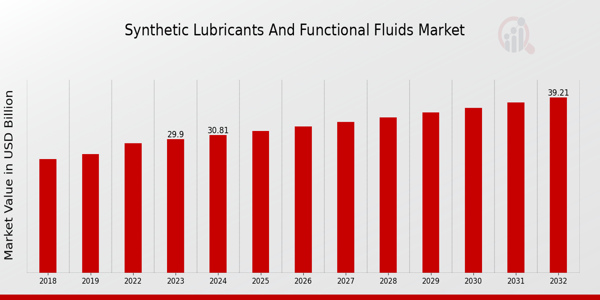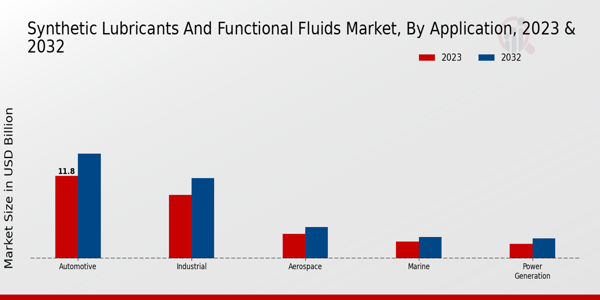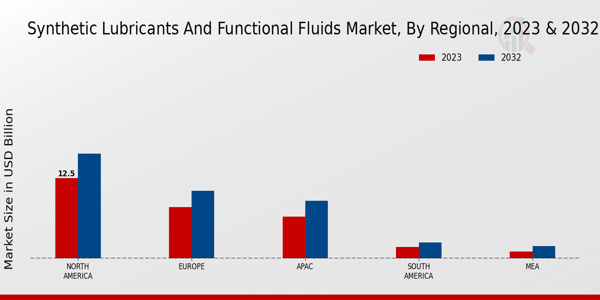Global Synthetic Lubricants and Functional Fluids Market Overview
The Synthetic Lubricants and Functional Fluids Market Size was estimated at 31.76 (USD Billion) in 2024. The Synthetic Lubricants and Functional Fluids Industry is expected to grow from 32.73 (USD Billion) in 2025 to 42.94 (USD Billion) by 2034. The Synthetic Lubricants and Functional Fluids Market CAGR (growth rate) is expected to be around 3.1% during the forecast period (2025 - 2034).
Key Synthetic Lubricants and Functional Fluids Market Trends Highlighted
The Synthetic Lubricants and Functional Fluids Market is witnessing significant growth driven by several key factors. An increasing focus on energy efficiency and sustainability is leading industries to adopt synthetic lubricants, which offer better performance and longer service life compared to conventional options. The automotive sector’s shift towards electric vehicles is also boosting demand for advanced lubricants that can operate effectively at higher temperatures. Furthermore, the stringent environmental regulations promoting the use of eco-friendly products are pushing manufacturers to innovate and develop synthetic alternatives that minimize environmental impact.The increasing need for lubricants that are biodegradable and based on renewable resources presents an opportunity. The growth of sectors including construction, aircraft, and marine presents an ideal environment for the development of novel uses for synthetic fluids. Additionally, as a result of growing industrialization and a rising standard of life, emerging markets provide substantial development potential. Investing in R&D to produce specialized products that fulfill changing industry standards and customer preferences allows companies to take advantage of these opportunities. A new trend in lubricants is the use of Internet of Things (IoT) technologies for predictive maintenance and monitoring, which can increase industrial efficiency.Another trend is the rise in partnerships and collaborations among companies seeking to leverage each other's strengths in innovation and distribution networks. The market is also seeing increased investment in automation and digitalization to enhance production capabilities and improve supply chain management, making operations more cost-effective. As industries continue to evolve, the demand for high-performance synthetic lubricants and functional fluids is expected to grow, making this an exciting area of focus for stakeholders.

Source: Primary Research, Secondary Research, MRFR Database and Analyst Review
Synthetic Lubricants and Functional Fluids Market Drivers
Increasing Demand for High-Performance Lubricants
The Synthetic Lubricants and Functional Fluids Market Industry is currently experiencing a significant shift toward high-performance lubricants, primarily driven by the need for improved efficiency and durability in machinery and equipment across various sectors. As industries such as automotive, manufacturing, and aerospace face growing pressure to enhance performance, the demand for synthetic lubricants that can withstand extreme temperatures, pressure, and chemical degradation is rising.These lubricants not only minimize wear and tear but also offer better stability and viscosity characteristics over their mineral counterparts. Synthetic lubricants play a critical role in reducing friction, leading to lower energy consumption and extended equipment life. Furthermore, as sustainability becomes increasingly important, many companies are transitioning to synthetic options that offer better biodegradability and lower environmental impact than traditional oils.This trend not only aids in meeting regulatory requirements but also aligns with corporate responsibility goals, making synthetic lubricants an integral part of sustainability strategies. The growth in electric vehicles also supplements this trend, as these vehicles require specific formulations to handle unique lubrication demands not seen in traditional internal combustion engines. Overall, the ongoing transition toward high-performance lubricants is expected to be a substantial driver of growth in the Synthetic Lubricants and Functional Fluids Market.
Growth of the Automotive Industry
The surge in the automotive industry directly influences the Synthetic Lubricants and Functional Fluids Market Industry, given the increasing reliance on synthetic oils for enhanced engine performance and longevity. As vehicle manufacturers advance technology to improve fuel efficiency and reduce emissions, synthetic lubricants play a crucial role. This demand is further supported by trends such as the rise of electric and hybrid vehicles, where advanced lubricants are essential for optimal performance.The expansion of global automotive production and sales indicates a corresponding growth in the need for high-quality synthetic lubricants that can meet specific automotive specifications.
Regulatory Push for Environmentally-Friendly Products
The push for stricter environmental regulations is driving innovation and adoption in the Synthetic Lubricants and Functional Fluids Market Industry. Governments worldwide are implementing regulations aimed at reducing harmful emissions and promoting sustainable practices, which has led to a heightened interest in eco-friendly products. Synthetic lubricants typically offer better biodegradability and performance profiles than their traditional counterparts, making them a preferred choice for industries seeking to meet compliance standards and enhance their sustainability metrics.This regulatory environment not only pushes manufacturers to innovate but also provides a competitive edge to those who embrace environmentally-friendly solutions.
Synthetic Lubricants and Functional Fluids Market Segment Insights
Synthetic Lubricants and Functional Fluids Market Application Insights
The Synthetic Lubricants and Functional Fluids Market is projected to reach a valuation of 29.9 USD Billion in 2023, reflecting the growing demand across various applications. Within the application segment, the Automotive sector is particularly noteworthy, holding a value of 11.8 USD Billion in 2023, and is expected to grow to 15.0 USD Billion by 2032, showcasing its majority holding within the market. This significance stems from the increasing complexity of modern vehicles, which demand high-performance lubricants for enhanced efficiency and maintenance.The Industrial sector, with a valuation of 9.1 USD Billion in 2023 and anticipated growth to 11.5 USD Billion by 2032, also plays a crucial role, as industries seek synthetic lubricants to improve machinery efficiency and extend equipment life, reflecting a steady demand driven by industrial automation and sustainability efforts. The Aerospace application, valued at 3.5 USD Billion in 2023 and projected to rise to 4.5 USD Billion by 2032, indicates importance in a field where reliability and performance are paramount due to operating in extreme conditions, thus necessitating the use of advanced lubricants.In contrast, the Marine sector, valued at 2.4 USD Billion in 2023 and expected to reach 3.1 USD Billion by 2032, represents a niche but significant segment where synthetic lubricants are increasingly utilized to enhance vessel performance and reduce environmental impact through more efficient fuel usage. Lastly, the Power Generation segment, starting at 2.1 USD Billion in 2023 and moving to 2.9 USD Billion by 2032, highlights the need for reliable lubricants in power generation equipment to ensure smooth operations and prevent failures, underscoring the essential role synthetic lubricants play in maintaining energy reliability.Overall, the Synthetic Lubricants and Functional Fluids Market segmentation reflects a well-rounded demand across these applications, driven by technological advancements, environmental regulations, and the pursuit of operational efficiency across various industries.

Source: Primary Research, Secondary Research, MRFR Database and Analyst Review
Synthetic Lubricants and Functional Fluids Market Product Type Insights
The Synthetic Lubricants and Functional Fluids Market is prominently segmented by product type, which includes Engine Oils, Hydraulic Fluids, Transmission Fluids, Gear Oils, and Compressor Oils. Engine oils play a crucial role, as they provide essential lubrication to automotive engines, enhancing performance and longevity. Hydraulic fluids are vital in various industrial applications, ensuring efficient operation of machinery, which reflects a growing trend toward automation. Transmission fluids are significant for maintaining seamless gear shifts in vehicles, contributing to overall efficiency.Gear oils are important for reducing wear and tear in mechanical components, especially in heavy-duty applications, while compressor oils are crucial for the efficient function of compressors across various industries. The continued growth in these product types is driven by the increasing demand for high-performance lubricants in both automotive and industrial applications, pushing the Synthetic Lubricants and Functional Fluids Market revenue to an expected value of 29.9 billion USD in 2023. The Synthetic Lubricants and Functional Fluids Market data highlights the need for advanced formulations to meet stringent environmental regulations and performance standards.Market statistics reveal that the sector is evolving, with a strong emphasis on innovation and sustainability to address challenges and tap into new opportunities.
Synthetic Lubricants and Functional Fluids Market Base Oil Type Insights
The Synthetic Lubricants and Functional Fluids Market, valued at 29.9 billion USD in 2023, presents a diverse landscape when it comes to the Base Oil Type segment. The market segmentation includes various types such as Esters, PAO, Group III, Group IV, and Synthetic Blends, each playing a distinct role in the market. Esters are particularly valued for their bio-based and eco-friendly properties, appealing to the growing consumer preference for sustainable options. On the other hand, PAO (Polyalphaolefins) is known for its high thermal stability and low volatility, making it a popular choice for high-performance applications.Group III base oils, which consist of highly refined mineral oils, have gained prominence due to their affordability and desirable properties, while Group IV oils, typically polyalphaolefins, are recognized for their superior performance across a range of temperatures. Synthetic Blends, known for their versatility, dominate portions of the market due to their ability to offer a balance between performance and cost. These factors create various growth drivers and opportunities for innovation within the Synthetic Lubricants and Functional Fluids Market industry, as companies continue to explore advancements in formulation and production techniques to meet diverse consumer needs.
Synthetic Lubricants and Functional Fluids Market End Use Insights
The Synthetic Lubricants and Functional Fluids Market is poised for growth, with particular emphasis on the End Use segment, encompassing various industries that rely on these products for operational efficiency and performance. In 2023, the market was valued at 29.9 billion USD, underscoring its vital role across sectors. In the automotive sector, synthetic lubricants are crucial for enhancing engine performance and extending oil change intervals, offering significant benefits in fuel efficiency. The manufacturing industry also relies heavily on these fluids to ensure machinery runs smoothly, reducing wear and prolonging equipment life.As construction activities continue to expand, effective lubricants help in machinery operation, ensuring uptime in demanding environments. The transportation sector benefits greatly from synthetic fluids that facilitate smoother operations, while the energy segment utilizes these lubricants to maintain equipment reliability and efficiency, especially in renewable energy applications. Overall, the Synthetic Lubricants and Functional Fluids Market revenue growth is driven by increasing industrial activity, technological advancements, and a shift towards more sustainable solutions.Market statistics reveal that these dynamics create ample opportunities for further development within the industry, enhancing its potential across varied applications.
Synthetic Lubricants and Functional Fluids Market Regional Insights
The Synthetic Lubricants and Functional Fluids Market demonstrates robust regional dynamics, reflecting significant variations in valuation across different areas. In 2023, North America leads the market with a valuation of 12.5 USD Billion, showcasing its dominance in the industry due to high industrial activity and demand for advanced lubricants. Europe follows with a valuation of 8.0 USD Billion, attributed to stringent environmental regulations promoting the use of synthetic options. The APAC region, valued at 6.5 USD Billion, is emerging due to increasing industrialization and automotive production, thus portraying a significant growth potential for synthetic lubricants.South America, with a valuation of 1.8 USD Billion, and the MEA region, valued at 1.1 USD Billion, present smaller but notable markets where ongoing development and expanding industrial bases are expected to drive future growth. Each region's unique economic landscape contributes to the differing market potential within the Synthetic Lubricants and Functional Fluids Market segmentation. Overall, the market statistics underscore the varied growth opportunities and challenges across these regions, emphasizing the need for tailored strategies to harness the potential within each area.

Source: Primary Research, Secondary Research, MRFR Database and Analyst Review
Synthetic Lubricants and Functional Fluids Market Key Players and Competitive Insights
The Synthetic Lubricants and Functional Fluids Market is characterized by a dynamic landscape influenced by various factors including technological advancements, regulatory frameworks, and shifting consumer preferences. Competitive insights reveal that major players are continuously innovating and investing in research and development to enhance their product offerings and cater to diverse industrial needs. The demand for synthetic lubricants is propelled by their superior performance attributes such as better thermal stability, extended service life, and environmental sustainability. As industries increasingly shift towards automation and energy efficiency, companies operating in this market are focusing on developing high-performance lubricants that can enhance machinery efficiency and lower operational costs. The competitive environment is also marked by strategic partnerships, acquisitions, and collaborations aimed at strengthening market positions and expanding geographical footprints.Chevron holds a strong presence in the Synthetic Lubricants and Functional Fluids Market, leveraging its extensive expertise and commitment to quality. The company is well-regarded for its innovation-driven approach, investing significantly in advanced technologies to tailor synthetic lubricants that meet specific requirements across various industries. Chevron's product portfolio includes a wide range of synthetic lubricants designed to offer reduced friction, enhanced lubrication properties, and increased equipment lifespan, providing customers with reliable solutions. The firm's global reach is supported by a robust distribution network, ensuring that its high-performance products are readily available to customers worldwide. Additionally, Chevron's emphasis on sustainability and environmentally friendly products aligns with the growing trends towards greener alternatives, solidifying its competitive edge in the market.Petrobras, a dominant player in the Synthetic Lubricants and Functional Fluids Market, capitalizes on its strong research and development capabilities to deliver innovative lubricant solutions. Recognized for its commitment to quality and performance, Petrobras produces a comprehensive range of synthetic lubricants that cater to various sectors such as automotive, industrial, and marine applications. The company boasts a reputation for formulating high-quality products that exhibit improved wear protection, thermal stability, and exceptional performance under extreme conditions. Its strategic initiatives focus on sustainability and resource efficiency, aligning with global trends toward environmentally conscious solutions. With a solid market presence and a focus on new product development, Petrobras continues to strengthen its competitiveness in the evolving lubricants landscape, ensuring it remains a key player in the industry.
Key Companies in the Synthetic Lubricants and Functional Fluids Market Include
- Chevron
- Petrobras
- Valvoline
- Amsoil
- TotalEnergies
- Castrol
- Chevron Phillips Chemical
- Fuchs Petrolub
- BP
- Lukoil
- Royal Dutch Shell
- SABIC
- Daewoo Engineering and Construction
- Indian Oil Corporation
- ExxonMobil
Synthetic Lubricants and Functional Fluids Market Industry Developments
Recent developments in the Synthetic Lubricants and Functional Fluids Market highlight a significant growth trajectory, driven by increasing demand for high-performance lubricants across various industries, including automotive and manufacturing. Companies like Chevron and ExxonMobil are expanding their product lines to meet evolving consumer needs, particularly in energy-efficient and long-lasting formulations. Notably, BP and TotalEnergies have been focusing on sustainable solutions, with initiatives to reduce the environmental impact of their product offerings. Furthermore, merger activity has been seen among key players, enhancing market position; for instance, Petrobras has been involved in strategic partnerships to bolster its operational efficiencies. Valvoline and Amsoil are also enhancing their market presence through acquisitions, aiming to leverage synergies in product development and distribution. Additionally, the valuation of companies such as Fuchs Petrolub and Royal Dutch Shell illustrates a positive shift in market dynamics. The overall market is benefiting from advancements in technology that improve lubrication performance and extend equipment life, making synthetic solutions increasingly appealing to manufacturers and consumers alike.
Synthetic Lubricants and Functional Fluids Market Segmentation Insights
- Synthetic Lubricants and Functional Fluids Market Application Outlook
- Automotive
- Industrial
- Aerospace
- Marine
- Power Generation
- Synthetic Lubricants and Functional Fluids Market Product Type Outlook
- Engine Oils
- Hydraulic Fluids
- Transmission Fluids
- Gear Oils
- Compressor Oils
- Synthetic Lubricants and Functional Fluids Market Base Oil Type Outlook
- Esters
- PAO
- Group III
- Group IV
- Synthetic Blends
- Synthetic Lubricants and Functional Fluids Market End Use Outlook
- Automotive
- Manufacturing
- Construction
- Transportation
- Energy
| Report Attribute/Metric |
Details |
| Market Size 2024 |
31.76 (USD Billion) |
| Market Size 2025 |
32.73 (USD Billion) |
| Market Size 2034 |
42.94 (USD Billion) |
| Compound Annual Growth Rate (CAGR) |
3.1% (2025 - 2034) |
| Report Coverage |
Revenue Forecast, Competitive Landscape, Growth Factors, and Trends |
| Base Year |
2024 |
| Market Forecast Period |
2025 - 2034 |
| Historical Data |
2020 - 2024 |
| Market Forecast Units |
USD Billion |
| Key Companies Profiled |
Chevron, Petrobras, Valvoline, Amsoil, TotalEnergies, Castrol, Chevron Phillips Chemical, Fuchs Petrolub, BP, Lukoil, Royal Dutch Shell, SABIC, Daewoo Engineering and Construction, Indian Oil Corporation, ExxonMobil |
| Segments Covered |
Application, Product Type, Base Oil Type, End Use, Regional |
| Key Market Opportunities |
Expansion in emerging markets, Increasing demand for eco-friendly products, Technological advancements in formulations, Growth in automotive and industrial sectors, Rising need for energy efficiency solutions |
| Key Market Dynamics |
growing demand for performance efficiency, increasing environmental regulations, technological advancements in formulations, rising automotive production, shift towards bio-based lubricants |
| Countries Covered |
North America, Europe, APAC, South America, MEA |
Frequently Asked Questions (FAQ) :
The projected market size in 2034 is expected to reach 42.94 USD Billion.
The expected CAGR for the market during this period is 3.1%.
North America is expected to hold the largest market share, valued at 16.3 USD Billion in 2034.
The Automotive application segment is anticipated to grow to 15.0 USD Billion by 2034.
The Industrial application segment is projected to reach 11.5 USD Billion in 2034.
Key players include Chevron, Petrobras, Valvoline, Amsoil, TotalEnergies, and BP among others.
The Aerospace application segment is valued at 3.5 USD Billion in 2024.
The Marine application segment is expected to reach 3.1 USD Billion in 2034.
The Power Generation application segment is valued at 2.1 USD Billion in 2024.
The APAC region is anticipated to have a market size of 9.0 USD Billion in 2034.

















